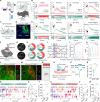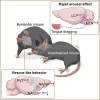Rescue-like behavior in a bystander mouse toward anesthetized conspecifics promotes arousal via a tongue-brain connection
- PMID: 39841840
- PMCID: PMC11753405
- DOI: 10.1126/sciadv.adq3874
Rescue-like behavior in a bystander mouse toward anesthetized conspecifics promotes arousal via a tongue-brain connection
Abstract
Prosocial behaviors are advantageous to social species, but the neural mechanism(s) through which others receive benefit remain unknown. Here, we found that bystander mice display rescue-like behavior (tongue dragging) toward anesthetized cagemates and found that this tongue dragging promotes arousal from anesthesia through a direct tongue-brain circuit. We found that a direct circuit from the tongue → glutamatergic neurons in the mesencephalic trigeminal nucleus (MTNGlu) → noradrenergic neurons in the locus coeruleus (LCNE) drives rapid arousal in the anesthetized mice that receive the rescue-like behavior from bystanders. Artificial inhibition of this circuit abolishes the rapid arousal effect induced by the rescue-like behavior. Further, we revealed that glutamatergic neurons in the paraventricular nucleus of the thalamus (PVTGlu) that project to the nucleus accumbens shell (NAcSh) mediate the rescue-like behavior. These findings reveal a tongue-brain connection underlying the rapid arousal effects induced by rescue-like behavior and the circuit basis governing this specific form of prosocial behavior.
Figures







Similar articles
-
A ventral pallidum-locus coeruleus-lateral hypothalamus pathway modulates brain arousal in freely behaving and isoflurane-anesthetized male mice.Nat Commun. 2025 May 16;16(1):4560. doi: 10.1038/s41467-025-59857-1. Nat Commun. 2025. PMID: 40379709 Free PMC article.
-
Activation of noradrenergic terminals in the reticular thalamus delays arousal from propofol anesthesia in mice.FASEB J. 2019 Jun;33(6):7252-7260. doi: 10.1096/fj.201802164RR. Epub 2019 Mar 12. FASEB J. 2019. PMID: 30860868
-
Sexual differences in locus coeruleus neurons and related behavior in C57BL/6J mice.Biol Sex Differ. 2023 Sep 28;14(1):64. doi: 10.1186/s13293-023-00550-7. Biol Sex Differ. 2023. PMID: 37770907 Free PMC article.
-
Discharge of noradrenergic locus coeruleus neurons in behaving rats and monkeys suggests a role in vigilance.Prog Brain Res. 1991;88:501-20. doi: 10.1016/s0079-6123(08)63830-3. Prog Brain Res. 1991. PMID: 1813931 Review.
-
Locus Coeruleus Norepinephrine in Learned Behavior: Anatomical Modularity and Spatiotemporal Integration in Targets.Front Neural Circuits. 2021 Jun 7;15:638007. doi: 10.3389/fncir.2021.638007. eCollection 2021. Front Neural Circuits. 2021. PMID: 34163331 Free PMC article. Review.
Cited by
-
Brain circuits that regulate social behavior.Mol Psychiatry. 2025 Jul;30(7):3240-3256. doi: 10.1038/s41380-025-03037-6. Epub 2025 Apr 26. Mol Psychiatry. 2025. PMID: 40287553 Free PMC article. Review.
-
Distinct oxytocin signaling pathways synergistically mediate rescue-like behavior in mice.Proc Natl Acad Sci U S A. 2025 Apr 29;122(17):e2423374122. doi: 10.1073/pnas.2423374122. Epub 2025 Apr 23. Proc Natl Acad Sci U S A. 2025. PMID: 40267134
References
-
- de Waal F. B. M., Preston S. D., Mammalian empathy: Behavioural manifestations and neural basis. Nat. Rev. Neurosci. 18, 498–509 (2017). - PubMed
-
- Sivaselvachandran S., Acland E. L., Abdallah S., Martin L. J., Behavioral and mechanistic insight into rodent empathy. Neurosci. Biobehav. Rev. 91, 130–137 (2018). - PubMed
-
- Keysers C., Knapska E., Moita M. A., Gazzola V., Emotional contagion and prosocial behavior in rodents. Trends Cogn. Sci. 26, 688–706 (2022). - PubMed
MeSH terms
LinkOut - more resources
Full Text Sources

